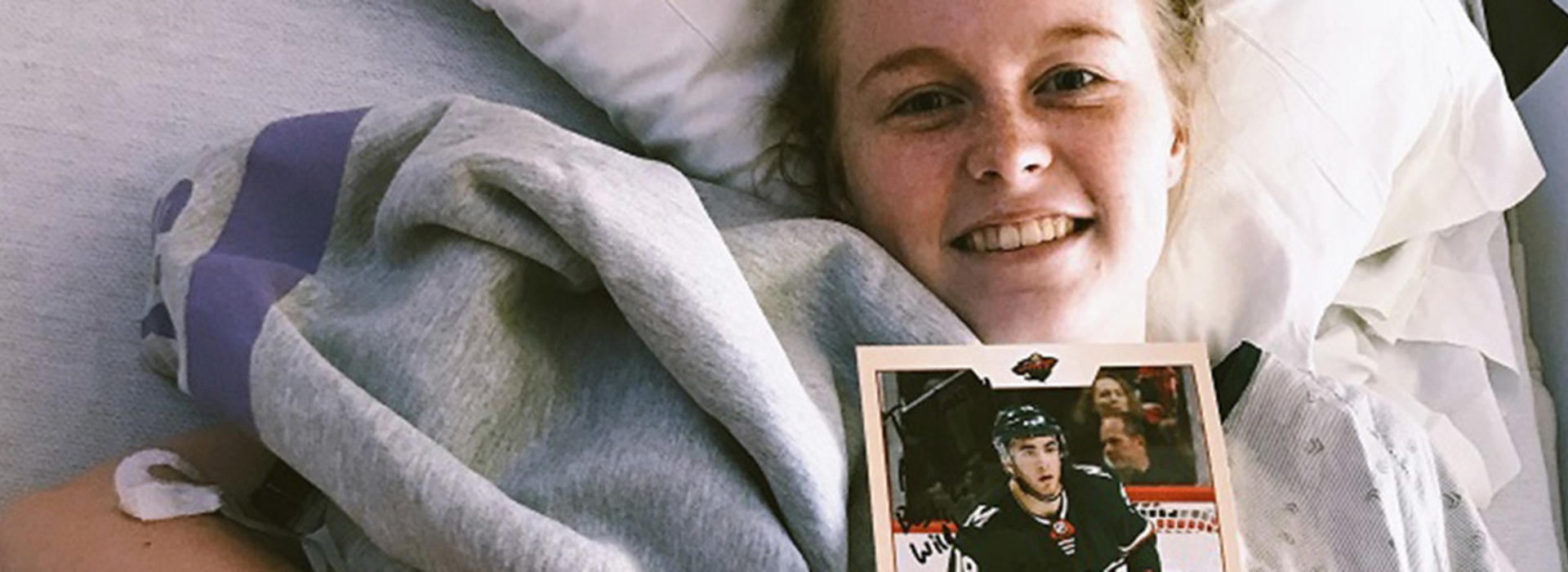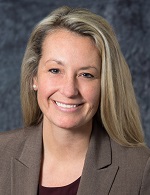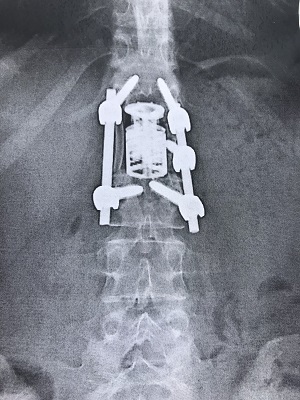
U of M surgical team removes tumor, reconstructs spine, and helps relieve debilitating pain for young patient
In the spring of 2018, Cassidy Clifton, a dynamic, personable 18-year-old resident of New Rockford, ND, began experiencing severe pain in her lower back. “I was in the most pain I’d ever had in my entire life,” she said. “I lost feeling in my thigh, hips, and other places. I was in constant pain … it never, ever stopped.”
Her local doctor took an MRI and discovered that Cassidy had a large aneurysmal bone cyst in the lower area of her spine. While referred to as a cyst, it is more precisely described as a progressively growing tumor that invades and destroys bone, causing pain and often instability of the associated bone. Aneurysmal bone tumors can occur in any bone, but are most commonly found around the knee, pelvis or spine, and happen most often in the first two decades of life.
Cassidy was eventually referred to Daniel Guillaume, MD, MS, Chief of Pediatric Neurosurgery at the University of Minnesota Masonic Children's Hospital in Minneapolis. He sent Cassidy to see Kristen Jones MD, an assistant professor in the Neurosurgery Department who specializes in complex spine and spinal deformity cases.

Complex spine and spinal deformity specialist, Kristen Jones, MD
Jones, who is dually trained in neurosurgical and orthopaedic surgery, recommended removing the entire vertebra associated with the tumor. “The only way to ensure that Cassidy’s tumor didn’t come back – based on its size and invasiveness – was to remove it and the surrounding bone completely,” explained Jones. On May 18, 2018, she led a team of University of Minnesota Medical Center surgeons who were prepared to do just that.
Treatment required teamwork
“To accomplish our goals, we operated on Cassidy’s spine both from the back and through her side,” Jones noted. “We worked quickly, thanks to assistance from Dr. Daniel Saltzman of pediatric surgery, who helped us work from the side of the spine and protected Cassidy’s lungs and abdominal organs during surgery. Dr. David Polly, who is head of Orthopaedic Spine Surgery, worked side by side with me to help make operative time as short as possible and minimize blood loss.” The team also included residents from General Surgery, Orthopaedic Surgery, and Neurosurgery.
“Without everyone’s expertise, we couldn’t have been as successful,” Jones continued. “It’s really a credit to the pediatric and orthopaedic surgery teams that we routinely work together so efficiently to do these complex cases. It was certainly the best solution for Cassidy.”
While removing the vertebra and the entire tumor, the surgical team had to be careful not to affect adjoining structures, such as the lung, abdominal organs, and the spinal cord. “We also needed to protect the nerves coming out of the bone at that level to ensure that Cassidy retained the full use of her legs,” Jones said.

Vertebra replaced with titanium cage
The team replaced Cassidy’s vertebra with a special type of graft – a titanium metal cage (pictured at right) – designed to support the weight carried by the original bone. “We then put rods and screws above and below the level where we worked to help hold everything in place and stabilize Cassidy’s spine” said Jones.
Following the procedure, Cassidy stayed in intensive care for three days and then in the hospital for a week. “I was in a lot of pain,” she said. “I don’t remember most of the time in the hospital, but I do remember feeling helpless because I needed assistance doing everything, even small things like turning over in bed.”
Because she had surgical incisions on both her side and her back, Cassidy’s recovery centered around managing her pain – and trying to find comfortable positions, especially at night. Seven months after the surgery she is still recovering but has no pain and takes no prescribed pain medication. “I can’t do anything athletic yet, but I’m very, very thankful for what I can do with no pain, like walking, sitting, and just being able to live normally,” she said.
Tumor is gone
Returning Cassidy to her other activities will take a little more time. “We are watching to make sure her bones heal completely,” noted Jones. “About a year after surgery, we expect that she will be able to return to full activity. Her pain is gone, which is a huge improvement. The best news for Cassidy is that the tumor was completely removed and she is where she should be neurologically.”
Cassidy is grateful that Jones, “was determined to put me out of my misery … and she was successful. She listened to me complain about how awful I felt and I could tell she put herself in my position. She told my family what they needed to hear even if they didn’t want to. I’m very thankful for Dr. Jones and would highly recommend her to anyone with spine trouble.”
Jones isn’t the only one Cassidy is grateful for. “I would like to thank everyone that helped me during my operation, prepped me before my surgery, and assisted me during my stay in the hospital,” she said. “I can’t thank you all enough. I’m slowly becoming myself again because of all of you.”



